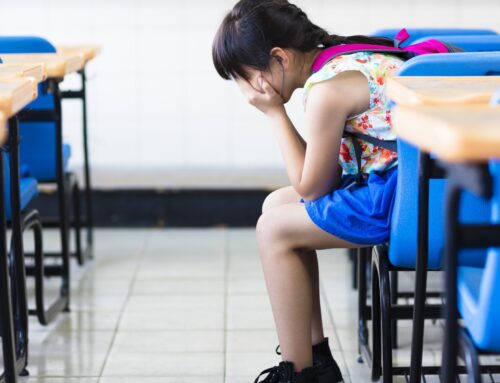
Educational labels are beacons of understanding.
At least, according to Education Week, that’s how they should work in an ideal world. The publication notes that labels “are supposed to work as beacons to help adults understand those students have special needs that may take ‘out of the box,’ thinking.”
In an ideal world, labels should work the way they were designed to.
And sometimes, they are helpful to educators, parents, and students alike. Educational labels such as “struggling reader” or “easily distracted” can ensure a student gets extra learning support and specialized instruction, according to Bright Hub Education. But they go on to say that this practice of labeling children according to their learning disability “can result in the student and educators reducing their expectations and goals for what can be achieved in the classroom.”
As a parent, this can be disturbing, to say the least. What if your child isn’t getting what he or she needs to grow? Is your child being boxed in by a label that doesn’t allow them to learn and experience at their own pace?
Which brings us to the real question: is there ever a place in education for labels?
We’ll look at the pros and cons today to get the full story.
What is educational labeling?
The National Center for Learning Disabilities reports that twenty percent of students “have learning and attention issues such as dyslexia and ADHD,” but this fact is widely misunderstood by both parents and educators. Many teachers believe that these more subtle learning disabilities are simply laziness, and parents are convinced that their child will just “grow out of it.”
Whether this disbelief stems from skepticism surrounding the real problem of over-diagnosis or a misunderstanding of the seriousness of legitimate learning struggles, this reaction from parents and teachers is nothing short of a tragedy—and it shows how susceptible educational labeling is to being seriously misused. Some children experience hasty, inaccurate labeling that drags them down, while others miss out on diagnoses that might offer them a path to improvement.
How did we get here?
Educational labeling was first introduced as a way of meeting students’ needs. For instance, a child who was labeled as “gifted” might move up in the curriculum, while a child with dyslexia might need to slow down or even repeat whole lessons or grades.
Education Week observes that, on one end of the spectrum, labels help children succeed by recognizing their strengths and playing to those strengths. But on the other hand, especially when it comes to children with learning differences and disabilities, “labels seem to put children in neat little boxes, and seem to benefit the adult in the classroom more than the student.”
Essentially, labels are a hack for teachers. Labels were never meant to stunt a child’s growth or stigmatize them, but a teacher who is pulled in a million directions by a couple dozen students—all with varying personalities and levels of growth— often welcomes a quick and easy way to categorize her class at a glance.
Labels allow that harried teacher to give her students exactly what they need, or so educators claim.
A student who is learning English as a second language is labeled as such and given classes to improve their English. A dyslexic child is given extra reading lessons until it clicks. An autistic child is examined as educators try to understand better how he or she learns and applies those techniques.
This sounds great. But do labels always work the way we want them to?
The dark side of labeling
Many educators and teachers want to break the mold. They don’t go along with the idea that you can define a child by a label. Parents, too, are becoming increasingly aware that what happens in school determines their children’s emotional well-being, not to mention affecting their level of success in life.
Could labels be part of the problem?
Children with a negative label or a disability are expected to come out below their peers. That’s just common sense, right? If you’re dyslexic, you’re not going to be as good at reading as someone who isn’t. In an article on Sage Journals, however, sociologist Dara Shifrer says “the more troubling possibility is that special education placement limits rather than expands these students’ opportunities.” In other words, labeling can box children in.
Kids with negative labels are more likely to be pitied rather than helped, even by their parents. Low expectations never helped anyone, much less a child who is ready and excited to learn. Just because that child has challenges doesn’t prevent him or her from overcoming them just like anyone else.
Children are sensitive and easily perceive when their peers treat them differently. They become shy and are often bullied. These children carry those memories—and, more than likely, that label—for the rest of their lives.
Being labeled also can mean that kids have very little opportunity to expand their experience outside of extra support classes and activities. Sometimes, teachers set children back a grade if they have not met standards in just one subject. In these situations, the child’s growth can be hampered, and they can become frustrated with the situation. And frustration drastically increases the chance of your child dropping out of high school later on.
Finally, every child is different. Every “disability” or learning challenge has a spectrum. Lumping students into groups where each gets the same special support can be damaging. In these scenarios, some children don’t get enough attention, while others are stuck repeating information they conquered long ago. Stereotyping children can be devastating and leaves children on both sides of the spectrum struggling to slow down or speed up.
Now that we’ve seen the adverse effects of educational labeling, we can ask a follow-up question. Can labels ever be used the right way?
How labels can help
Despite the cons, labeling can help children with learning disabilities to get the help they need. In public schools, funding for special education programs relies on categories of disabilities, a paper by the University of North Carolina Wilmington says. To get funded at the federal and local levels, schools must report on disabilities and needs in their students.
Education labeling is an easy way to understand what a child might be struggling with and how educators and professionals can help them grow. Labels are extremely important to researchers and health professionals as well, for communication purposes. After all, how could we identify and support a child with dyscalculia if we didn’t know what dyscalculia looks like? Research done with other children who have struggled with math gives us a starting point.
Among professionals, then, there is a useful place for labeling. But when it comes to the kids themselves, the truth is that they don’t need to be put in a box to be understood. Children should be allowed to grow at their own pace. Under wise instruction and role modeling, they’ll flourish.
Finding the sweet spot
“Without the right academic or emotional support, [students] are much more likely than their peers to repeat a grade, get suspended, and drop out,” the National Center for Learning Disabilities points out. They’ve done plenty of research to back up their statements, too. People who have learning disabilities struggle in the workplace after school and are more likely to be involved in crime.
If labeling can help children get the education they need to become happy, functional adults, then we’re here for it! But so often labeling doesn’t benefit children at all.
As parents, we don’t have to let a label define our children. We never should. But how do we counteract the trends?
Allowing children to have space to learn and grow at home is the perfect place to start. Give your child your time and attention, read books, go on adventures. A rich home life can help a child through learning struggles far more effectively than a classroom setting ever will. The Learning Disabilities Association of America sums it up best when they say that a child’s natural gifts are “far more important than perfect recitation of the alphabet or copying letters. All children can make progress, but the rate and amount of improvement varies.”
If you’re searching for a school right now, look for one where the teachers understand this concept. Finding open-minded educators who will appreciate and encourage your child’s strengths is one of the best favors you’ll ever do yourself and your child.
Educational labels have their uses.
In their proper sphere, they can do a lot of good. But not always. If we allow the labeling system to box in children and prevent them from reaching their full potential, we’re headed in the wrong direction. Instead, let’s set the bar high and let our children thrive!




